Caryn’s Thoughts

 For many people, 2020 and 2021 have been hard and disappointing years, but for my niece, Michelle Miller, this past year has been a banner year. So many wonderful things have transpired in her life, that she can’t help but be jumping for joy, and excited for the future and all that it will bring with it. Michelle and her long-time love…literally since middle school, Matt Miller tied the knot this summer in a sweet ceremony on Casper Mountain on August 14, and they have been busy starting their new life as a married couple. They are so happy together and such great friends, on top of now being husband and wife. They are so perfect for each other. It is a sweet mixture of macho man meets the artist, and while the two things might seem very different, these two somehow blend together perfectly. While Michelle is an artist, she also likes to get outdoors with Matt…well, maybe not the hunting and fishing parts…more the camping part, but that works out well for both of them.
For many people, 2020 and 2021 have been hard and disappointing years, but for my niece, Michelle Miller, this past year has been a banner year. So many wonderful things have transpired in her life, that she can’t help but be jumping for joy, and excited for the future and all that it will bring with it. Michelle and her long-time love…literally since middle school, Matt Miller tied the knot this summer in a sweet ceremony on Casper Mountain on August 14, and they have been busy starting their new life as a married couple. They are so happy together and such great friends, on top of now being husband and wife. They are so perfect for each other. It is a sweet mixture of macho man meets the artist, and while the two things might seem very different, these two somehow blend together perfectly. While Michelle is an artist, she also likes to get outdoors with Matt…well, maybe not the hunting and fishing parts…more the camping part, but that works out well for both of them.
Michelle is an artist, like I said, obtaining her art degree for Black Hills State University. When she and Matt moved back to Casper, Wyoming from Spearfish, South Dakota, she began to apply to the Natrona County School District. Unfortunately for the school district, they didn’t have an opening, and Michelle took a job with The Nicolaysen Art Museum as an Art Educator. While she had envisioned herself as a public school art teacher, Michelle quickly addapted to her new career, and…well, has this ever been a wonderful career move for her. In October 2021, Michelle received a huge promotion from Art teacher to Curator of Education. It was a very big promotion. Her boss was very much on board with her moving up, and her family is all very pleased with her new position too. Michelle will be writing grants and getting all parts of the education program’s set up. It rather like the type of promotion when a teacher becomes school principal, except that most teachers have to be teaching for years before such a promotion comes their way…but then Michelle is very a unique and special teacher. She is very happy with her new career and responsibilities. She also has the added benefit of being able to continue to teach some of her classes, something that she would have hated to have to give up. Michelle is and always will be a teacher first.
Michelle and Matt are currently living in an apartment, but they are beginning to put out some feelers concerning a home of their own They want a house, but they are actually looking for a piece of land where they can have room to have a big shop and maybe even an art studio…I hope, because Michelle, while she is Curator of Education, and an art teacher, is really, first and foremost, an artist. I have seen her work, and it is amazing. I believe she could easily sell her work, and I know people would be quick to buy. With their big future plans, 
 they are actively looking around for that perfect property, but they haven’t found one that suits their needs yet. I’m sure that it is out there. God has the perfect place for them, and He will show it to them with the timing is just right too. Yeah, still in the same place. I know that when He shows them the perfect place, they will see that it is perfect too. We are very excited for them to be able to start their next chapter of their lives. Today is Michelle’s birthday. Happy birthday Michelle!! Have a great day!! We Love you!!
they are actively looking around for that perfect property, but they haven’t found one that suits their needs yet. I’m sure that it is out there. God has the perfect place for them, and He will show it to them with the timing is just right too. Yeah, still in the same place. I know that when He shows them the perfect place, they will see that it is perfect too. We are very excited for them to be able to start their next chapter of their lives. Today is Michelle’s birthday. Happy birthday Michelle!! Have a great day!! We Love you!!
 Today would have been my grandniece, Hallie Joy Moore’s first earthly birthday, had she not moved to Heaven shortly after her birth last year. I have been thinking about how different her life, and that of her family, has been because she is not here with us. For Hallie, I’m sure that her life now is more exciting than we could have ever imagined. We can only imagine what it would be like to live with Jesus in Heaven, but she is living that wonderful life right now. While she would just be learning to walk here, she would have mastered that skill immediately following her move to Heaven last year. There is no sadness there, so she has been very happy, and looking forward to having her family join her there one day, so she can show that all of the amazing things there are to do there. Her excitement about their future move to Heaven must be off the charts, because that’s just how kids are…always excited…about everything.
Today would have been my grandniece, Hallie Joy Moore’s first earthly birthday, had she not moved to Heaven shortly after her birth last year. I have been thinking about how different her life, and that of her family, has been because she is not here with us. For Hallie, I’m sure that her life now is more exciting than we could have ever imagined. We can only imagine what it would be like to live with Jesus in Heaven, but she is living that wonderful life right now. While she would just be learning to walk here, she would have mastered that skill immediately following her move to Heaven last year. There is no sadness there, so she has been very happy, and looking forward to having her family join her there one day, so she can show that all of the amazing things there are to do there. Her excitement about their future move to Heaven must be off the charts, because that’s just how kids are…always excited…about everything.
 Hallie was a beautiful little girl. I think she looked a lot like her mommy, Lindsay Moore, with some of her daddy, Shannon Moore sprinkled in, and maybe some of her big sister, Mackenzie Moore in there too. It was a beautiful combination, for sure. She was born about two months before she was supposed to arrive, and I suppose that was just too early. While it made us all very sad to have her leave us, we also know exactly where she went, and that part makes us very happy…for her anyway. Hallie’s name was chosen for her with much love and happiness in mind. Her name Hallie means “Praise the Lord” and Joy, of course, means “happiness.” Both were perfectly chosen for her by her loving parents, and I think they are beautiful names. I can’t wait to meet little Hallie when I go home to Heaven. Today would have been Hallie’s 1st birthday. Happy birthday in Heaven Hallie. We love and miss you very much.
Hallie was a beautiful little girl. I think she looked a lot like her mommy, Lindsay Moore, with some of her daddy, Shannon Moore sprinkled in, and maybe some of her big sister, Mackenzie Moore in there too. It was a beautiful combination, for sure. She was born about two months before she was supposed to arrive, and I suppose that was just too early. While it made us all very sad to have her leave us, we also know exactly where she went, and that part makes us very happy…for her anyway. Hallie’s name was chosen for her with much love and happiness in mind. Her name Hallie means “Praise the Lord” and Joy, of course, means “happiness.” Both were perfectly chosen for her by her loving parents, and I think they are beautiful names. I can’t wait to meet little Hallie when I go home to Heaven. Today would have been Hallie’s 1st birthday. Happy birthday in Heaven Hallie. We love and miss you very much.
 During their reign of terror, Japan, like Germany had their sights set on world domination. Japanese troops landed in Hong Kong on December 18, 1941, and an immediate slaughter began. The process started with a week of air raids over Hong Kong, which was a British Crown Colony at the time. Then on December 17, Japanese envoys paid a visit to Sir Mark Young, who was at that time, the British governor of Hong Kong.
During their reign of terror, Japan, like Germany had their sights set on world domination. Japanese troops landed in Hong Kong on December 18, 1941, and an immediate slaughter began. The process started with a week of air raids over Hong Kong, which was a British Crown Colony at the time. Then on December 17, Japanese envoys paid a visit to Sir Mark Young, who was at that time, the British governor of Hong Kong.
The envoys’ message was simple: “The British garrison there should simply surrender to the Japanese—resistance was futile.” The envoys were sent home with the following retort: “The governor and commander in chief of Hong Kong declines absolutely to enter into negotiations for the surrender of Hong Kong…”
The unsuccessful negotiations brought a swift wave of Japanese troops, who in retaliation for the refused surrender, landed in Hong Kong with artillery fire for cover and the following order from their commander: “Take no prisoners.” The troops quickly overran a volunteer antiaircraft battery, and the Japanese invaders roped together the captured soldiers. In a complete disregard for human life, a complete disregard for the Geneva Convention rules, or any rules of common decency, the Japanese proceeded to bayonet them to death. Even those who offered no 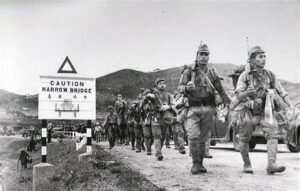 resistance, such as the Royal Medical Corps, were led up a hill and killed. They showed no mercy, just hate and evil. Following the initial slaughter, the Japanese took control of key reservoirs. With the water under their control, they threatened the British and Chinese inhabitants with a slow death by thirst. With their backs against a wall, the British finally surrendered control of Hong Kong on Christmas Day.
resistance, such as the Royal Medical Corps, were led up a hill and killed. They showed no mercy, just hate and evil. Following the initial slaughter, the Japanese took control of key reservoirs. With the water under their control, they threatened the British and Chinese inhabitants with a slow death by thirst. With their backs against a wall, the British finally surrendered control of Hong Kong on Christmas Day.
On that same day, the War Powers Act was passed by Congress, authorizing the president to initiate and terminate defense contracts, reconfigure government agencies for wartime priorities, and regulate the freezing of foreign assets. It also permitted him to censor all communications coming in and leaving the country. President Franklin D Roosevelt appointed the executive news director of the Associated Press, Byron Price, as director of censorship. Although invested with the awesome power to restrict and withhold news, Price took no extreme measures, allowing news outlets and radio stations to self-censor, which they did. Most top-secret information, including the construction of the atom  bomb, remained just that…strangely, but then those were different times.
bomb, remained just that…strangely, but then those were different times.
“The most extreme use of the censorship law seems to have been the restriction of the free flow of “girlie” magazines to servicemen…including Esquire, which the Post Office considered obscene for its occasional saucy cartoons and pinups. Esquire took the Post Office to court, and after three years the Supreme Court ultimately sided with the magazine.” It amazes me just how much times have changed. These days the “girlie” trash is totally acceptable, but truth is censored and lies are allowed. Too bad we are so far out from those days.
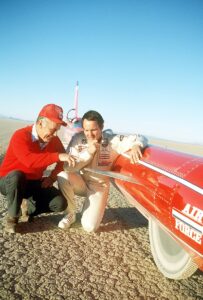 We all know what it means to travel faster than the speed of sound…at least in theory. And most of us believe that it takes an airplane to accomplish that feat. That said, I wonder how Hollywood stuntman Stan Barrett felt when, on December 17, 1979, he blasted across a dry lakebed at California’s Edwards Air Force Base in a rocket and missile-powered car, becoming the first man to travel faster than the speed of sound on land. The reality is that there is no proof that he actually accomplished what he set out to do, which was to see if he could go faster than the speed of sound, because unfortunately, the radar scanner was acting up, and so Barrett’s top speed of 739.666 miles per hour by the most reliable measure, ended up being no more than an estimate. In addition, he only drove his rocket car across the lakebed once, while official record guidelines require that it be done twice. Also, none of the spectators heard a sonic boom as Barrett zoomed across the course. Nevertheless, it is believed that he did indeed break the sound barrier.
We all know what it means to travel faster than the speed of sound…at least in theory. And most of us believe that it takes an airplane to accomplish that feat. That said, I wonder how Hollywood stuntman Stan Barrett felt when, on December 17, 1979, he blasted across a dry lakebed at California’s Edwards Air Force Base in a rocket and missile-powered car, becoming the first man to travel faster than the speed of sound on land. The reality is that there is no proof that he actually accomplished what he set out to do, which was to see if he could go faster than the speed of sound, because unfortunately, the radar scanner was acting up, and so Barrett’s top speed of 739.666 miles per hour by the most reliable measure, ended up being no more than an estimate. In addition, he only drove his rocket car across the lakebed once, while official record guidelines require that it be done twice. Also, none of the spectators heard a sonic boom as Barrett zoomed across the course. Nevertheless, it is believed that he did indeed break the sound barrier.
Barrett, who was a 36-year-old stuntman and ex-lightweight Golden Glove champion, was introduced to auto racing by Paul Newman in 1971. At the time, he was Newman’s stunt double for the film “Sometimes a Great Notion.” Barrett’s car, the $800,000 Budweiser Rocket, was owned by movie director, Hal  Needham, who was himself a former racer. Needham had broken a nine-year-old world land-speed record on the Bonneville Salt Flats the previous September. The car he drove had a 48,000-horsepower rocket engine and, to give it a little extra kick, a 12,000-horsepower Sidewinder missile.
Needham, who was himself a former racer. Needham had broken a nine-year-old world land-speed record on the Bonneville Salt Flats the previous September. The car he drove had a 48,000-horsepower rocket engine and, to give it a little extra kick, a 12,000-horsepower Sidewinder missile.
December 17th was a dry day with temperatures around 20° Fahrenheit. Because of the cold, Barrett would actually have to go faster than the 731.9 miles per hour required, in order to break the sound barrier under those conditions. He started the rocket engine and stepped on the gas. He counted to 12, pushed the button on his steering wheel to fire the Sidewinder, so he could go even faster. After he zoomed past a battery of timing devices, Barrett deployed a parachute to help him slow down. It took only a few seconds for Barrett to blast across the 5¾ mile long lakebed. Most of us would have a hard time wrapping our heads around that.

The run was perfect, but unfortunately, the radar speedometers on the ground malfunctioned. Instead of recording the Rocket’s speed, they captured the speed of a passing truck, which was only 38 miles per hour. They would have to look elsewhere for confirmation, and in the end, the speed estimate came from data by the Air Force, whose scanners seemed to indicate that the Rocket had “probably exceeded the speed of sound.” The controversy over how fast Barrett actually went is still disputed to this day. It took until October 1997 for another driver, in a British car called the Thrust SSC, to officially break the Mach 1 sound barrier.

 Any army is going to try attack the enemy in a sneaky way, so that their enemy is not ready…and indeed, has no idea the enemy is even nearby. When it comes to sneak attacks, we often think about the Japanese and Pearl Harbor, but they were not the only ones to do it. The Germans were just as likely to sneak up on their targets as the Japanese.
Any army is going to try attack the enemy in a sneaky way, so that their enemy is not ready…and indeed, has no idea the enemy is even nearby. When it comes to sneak attacks, we often think about the Japanese and Pearl Harbor, but they were not the only ones to do it. The Germans were just as likely to sneak up on their targets as the Japanese.
At approximately 8am on December 16, 1914, Franz von Hipper sent German battle cruisers from his Scouting Squadron to attack the British navy. The attack caught the British completely by surprise, as the Germans began heavy bombardment of Hartlepool and Scarborough…two English port cities on the North 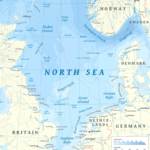 Sea. In the attack that lasted an hour and a half, the Germans killed more than 130 civilians and wounded another 500. The attack brought a swift and vicious response from the British press, who called the incident another example of German brutality. The German navy countered that the two port cities were valid targets due to their fortified status. It didn’t justify the attack, but it was the excuse the Germans used.
Sea. In the attack that lasted an hour and a half, the Germans killed more than 130 civilians and wounded another 500. The attack brought a swift and vicious response from the British press, who called the incident another example of German brutality. The German navy countered that the two port cities were valid targets due to their fortified status. It didn’t justify the attack, but it was the excuse the Germans used.
The attack was quickly answered by the British. Two defense batteries in Hartlepool were dispatched to attack the German vessels, damaging three of them, including the heavy cruiser, Blucher. Hipper’s plan was to draw the British forces to pursue them across waters freshly laced with mines. They also had another German fleet, commanded by Admiral Friedrich von Ingenohl, waiting offshore to provide support. The plan fell through when the hoped-for major confrontation did not take place. Instead, the British decided to keep most of their fleet, which had been depleted by the dispatch of their major cruisers to pursue the dangerous squadron of Admiral Maximilian von Spee, in the harbor.


The Scouting Squadron attempted a repeat attack one month later using the same tactics used to surprise the British at Scarborough and Hartlepool. That attempt resulted in the Battle of Dogger Bank, where Hipper’s squadron was defeated, but unfortunately managed to avoid capture. The biggest drawback of a sneak attack is that it can really only be used once. After that the enemy is prepared and watching.
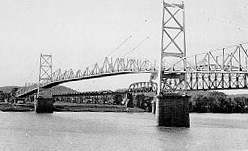
 Over time, architecture has taken many turns. Some buildings last for thousands of years, and others struggle to last a hundred years. Also, some structures go through more things that can degrade them, such as the elements and usage. Such as the case with the Silver Bridge. The Silver Bridge was built in 1928 and connected Point Pleasant, West Virginia with Gallipolis, Ohio via US Route 35, taking it over the Ohio River. It was an eyebar-chain suspension bridge. The bridge got its name from the color of its aluminum paint.
Over time, architecture has taken many turns. Some buildings last for thousands of years, and others struggle to last a hundred years. Also, some structures go through more things that can degrade them, such as the elements and usage. Such as the case with the Silver Bridge. The Silver Bridge was built in 1928 and connected Point Pleasant, West Virginia with Gallipolis, Ohio via US Route 35, taking it over the Ohio River. It was an eyebar-chain suspension bridge. The bridge got its name from the color of its aluminum paint.
The bridge was less that 40 years old when disaster struck on December 15, 1967. It is said that the bridge 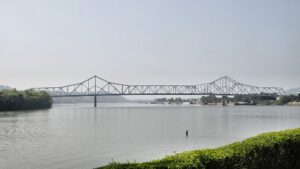 collapsed under the weight of rush-hour traffic, but that seems extreme to me. How many cars would it take to break a bridge, and how would they all fit on the bridge to make it break? When the bridge came down, 46 people lost their lives. Search and rescue operations were immediately put in place, and 44 people were found, but two of the victims were never found. When the bridge was rebuilt in 1969, it would be both a bridge and a memorial to those who lost their lives that fateful day.
collapsed under the weight of rush-hour traffic, but that seems extreme to me. How many cars would it take to break a bridge, and how would they all fit on the bridge to make it break? When the bridge came down, 46 people lost their lives. Search and rescue operations were immediately put in place, and 44 people were found, but two of the victims were never found. When the bridge was rebuilt in 1969, it would be both a bridge and a memorial to those who lost their lives that fateful day.
No such disaster can take place without an investigation following it, to determine the cause. The causes of these disasters actually help to correct the flaws so that things like this don’t happen in the future. The investigation into the cause of the Silver Bridge collapse came down to the failure of just one eyebar. I suppose that once that one gave way, the load was too much for the rest of the eyebar links. It was further determined that the eyebar that failed had a 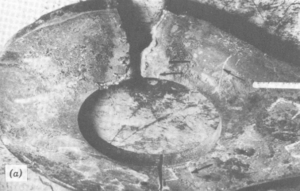
 small defect 0.1 inches deep. The analysis showed that the bridge was carrying much heavier loads than it was designed for. Cars were heavier too and there were more of them, putting more strain on the small defect in the eyebar. In addition, the bridge had been poorly maintained, further weakening the structure. These days, bridges can still fail, but they maybe don’t quite as often, and most last longer than 40 years.
small defect 0.1 inches deep. The analysis showed that the bridge was carrying much heavier loads than it was designed for. Cars were heavier too and there were more of them, putting more strain on the small defect in the eyebar. In addition, the bridge had been poorly maintained, further weakening the structure. These days, bridges can still fail, but they maybe don’t quite as often, and most last longer than 40 years.

 I find it so hard to believe that my great grandniece, Reece Balcerzak is four years old. Her life started out pretty scary, but she is a strong girl, and she pulled through, quickly proving that a premature birth and a long hospital stay was not going to stop this “little firecracker.” She is full of life and energy. She is her mommy, Katie Balcerzak’s mini-me, and her daddy, Keifer Balcerzak’s pride and joy. This precious little girl definitely keeps her parents on their toes.
I find it so hard to believe that my great grandniece, Reece Balcerzak is four years old. Her life started out pretty scary, but she is a strong girl, and she pulled through, quickly proving that a premature birth and a long hospital stay was not going to stop this “little firecracker.” She is full of life and energy. She is her mommy, Katie Balcerzak’s mini-me, and her daddy, Keifer Balcerzak’s pride and joy. This precious little girl definitely keeps her parents on their toes.
These days, Reece has a new title. She is big sister to her brother Aysa Balcerzak, who arrived on November 8, 2021. I really think Reece feels like this is her most important title. Having a baby brother means that she has lots of new jobs. She can go get things for her parents, entertain her brother, and generally love on her brother…which she does very well. Reece and her parents might not have known how much they “needed” Aysa, but I think they do now. For Reece, having a sibling is very cool…for now. We all know how 
 siblings can get, but they always love each other…always. Aysa is going to be very blessed to have such a sweet big sister as Reece, and she will be very blessed by him.
siblings can get, but they always love each other…always. Aysa is going to be very blessed to have such a sweet big sister as Reece, and she will be very blessed by him.
Reece is spreading her wings these days to find out what kinds of things she likes to do. She tried t-ball and had a good time. I’m not sure how she felt about the game itself, but she has plenty of time to explore athletic ideas. One thing that Reece has already perfected is her great…and I really mean great smile. That little girl is always happy, and her face is always lit up. Not everyone has such a gift. Reece is a joyous little girl, and a great blessing to her parents, grandparents, and everyone who knows her. Today is Reece’s 4th birthday. Happy birthday Reece!! Have a great day!! We love you!!
 Maybe they were just wanting to be home for Christmas, and not knowing exactly how long it would take…while hiding out from the law, that is…the Texas Seven decided to get a jump start on the journey. No, probably not. It wasn’t Christmas with loved ones that was on their minds…it was freedom. On December 13, 2000, seven prisoners dubbed the “Texas Seven” by the media, broke out of maximum-security prison in South Texas, setting off a massive six-week manhunt. The prisoners were Joseph Christopher Garcia, Randy Ethan Halprin, Larry James Harper, Patrick Henry Murphy Jr, Donald Keith Newbury, George Angel Rivas Jr, and Michael Anthony Rodriguez. The escapees overpowered civilian employees and prison guards in the maintenance shop where they worked and stole clothing, guns, and a vehicle. The men left a note saying: “You haven’t heard the last of us yet,” and they were right. These men were convicted of crimes like murder, rape, and robbery. They were set to be executed soon, so they had nothing to lose.
Maybe they were just wanting to be home for Christmas, and not knowing exactly how long it would take…while hiding out from the law, that is…the Texas Seven decided to get a jump start on the journey. No, probably not. It wasn’t Christmas with loved ones that was on their minds…it was freedom. On December 13, 2000, seven prisoners dubbed the “Texas Seven” by the media, broke out of maximum-security prison in South Texas, setting off a massive six-week manhunt. The prisoners were Joseph Christopher Garcia, Randy Ethan Halprin, Larry James Harper, Patrick Henry Murphy Jr, Donald Keith Newbury, George Angel Rivas Jr, and Michael Anthony Rodriguez. The escapees overpowered civilian employees and prison guards in the maintenance shop where they worked and stole clothing, guns, and a vehicle. The men left a note saying: “You haven’t heard the last of us yet,” and they were right. These men were convicted of crimes like murder, rape, and robbery. They were set to be executed soon, so they had nothing to lose.
These were not the kind of people that anyone wanted to have running around the state…or anywhere outside of prison walls. Soon after escaping from the Connally Unit lockup in Kenedy, Texas, the fugitives picked up another getaway vehicle. This one provided by the father of one of the men. They robbed a Radio Shack store in Pearland, Texas, coming out with cash and police scanners. On Christmas Eve, the escapees struck a sporting-goods store in Irving, Texas, where they stole a large amount of cash and weapons. In the process, the men killed police officer Aubrey Hawkins, shooting him multiple times with multiple weapons and running him over. Now they really had nothing to lose. Now, they were cop killers on top of everything else. It looked like it was time to get out of Dodge…or in this case, Texas.
The Texas Seven headed to Colorado, where they purchased a motor home and told people they were Christian missionaries. They rented a spot at a trailer park near Woodland Park, Colorado. They were there about a month before things started to fall apart. On January 22, 2001, after seeing the “Texas Seven” profiled on the TV program America’s Most Wanted, someone tipped off the police to the group of seven “missionaries” near Woodland Park. During the raid, ringleader George Rivas was captured along with three of the other men. Larry James Harper decided that he was not going back to prison, so he committed suicide after being surrounded by  police. Two days later, law enforcement officials closed in on the two remaining escapees at a hotel in Colorado Springs. A standoff ensued, during which the fugitives conducted phone interviews with a TV news station and claimed their escape was a protest against Texas’ criminal justice system. Someone always has to add a bit of drama to justify their new crimes. There was no evidence indicating their claim was justified. The men then surrendered to authorities. Their crime spree was over. Of the six remaining, four have since been executed. Randy Ethan Halprin and Patrick Henry Murphy Jr are currently back at Polunsky Unit in Livingston, Texas on Death Row awaiting execution.
police. Two days later, law enforcement officials closed in on the two remaining escapees at a hotel in Colorado Springs. A standoff ensued, during which the fugitives conducted phone interviews with a TV news station and claimed their escape was a protest against Texas’ criminal justice system. Someone always has to add a bit of drama to justify their new crimes. There was no evidence indicating their claim was justified. The men then surrendered to authorities. Their crime spree was over. Of the six remaining, four have since been executed. Randy Ethan Halprin and Patrick Henry Murphy Jr are currently back at Polunsky Unit in Livingston, Texas on Death Row awaiting execution.

 December 12, 2007…a day that rocked my world. It was a day I never expected to see…the day my dad, Allen Spencer went home to be with the Lord. I don’t know why it never occurred to me that someday my parents would be in Heaven, but it didn’t. Nevertheless, these days, all we have are the memories, as we wait for the day when we will all be together again in Heaven.
December 12, 2007…a day that rocked my world. It was a day I never expected to see…the day my dad, Allen Spencer went home to be with the Lord. I don’t know why it never occurred to me that someday my parents would be in Heaven, but it didn’t. Nevertheless, these days, all we have are the memories, as we wait for the day when we will all be together again in Heaven.
My dad was a great guy. He was a girl dad, and he wore it well. I don’t know how he managed to survive having five daughters and a wife, all vying for one bathroom, but he did. Ours was probably what the song writer meant, when he wrote “Love Grows Best In Little Houses.” It never felt crowded. It always felt just right. I wonder if my parents knew, when I was just 3 years old that the house they bought then, would be their forever home. At that time my older sister, Cheryl Masterson and I believe my younger sister, Caryl Reed were there, as well as I was. Two more daughters would join the family in that little house, now forever home. There were a few changes, like converting the garage to a bedroom and a utility room, that gave a little more space. Then, in my parents’ later years, an enclosed porch was added. The house just always felt like home…to all of us. Of course, it was our parents that really made the house a home. Their love filled the house, and we were always blessed by them and their love. Any house can hold a family, but love is what makes a house a home.
The first time the house ever felt empty, and maybe a little wrong, was after my dad went home to Heaven. Mom’s lifelong companion was gone now, as was our dad, who had always made us feel like princesses. We could see him in every room, but these were just memory visions. His love still lingered in each and every room. We knew that he still loves us, of course, but everything suddenly felt wrong…like the world kept going, but he had stopped. That is what happened, of course, but it felt to us like life had stepped out or its proper order. We would notice the same thing a few years later, when our mom, Collene Spencer went home to join Dad in Heaven. The house was still filled with the memory visions of them and their love, but it was kind of empty and lonely somehow.
Each year as we remember their homegoings, we are reminded of just how precious they were to us, and how we want to make them proud of how we have lived our lives. They raised us well, and taught us to love God and country, and to always try to do the right things. Now, we look forward to the day we will join them in Heaven, because that is where they are waiting in our future in Heaven, and what a joyous day it will be when we join them there. We love and miss you both on this, the 14th anniversary of your homegoing, Dad, and we can’t wait to see you again.

 My nephew, Barry Schulenberg is a very driven man. He is always busy doing something. If he’s not working at his job as a mechanic for the State of Wyoming, he is taking care of his property east of Casper; helping his Uncle Ron Schulenberg with things like cutting wood for his wood stove; or hiking with his wife, Kelli and their dog Scout. Barry is pretty much always busy.
My nephew, Barry Schulenberg is a very driven man. He is always busy doing something. If he’s not working at his job as a mechanic for the State of Wyoming, he is taking care of his property east of Casper; helping his Uncle Ron Schulenberg with things like cutting wood for his wood stove; or hiking with his wife, Kelli and their dog Scout. Barry is pretty much always busy.
Barry is the field mechanic for the State of Wyoming in Casper. Being a field mechanic is far more interesting than just your average everyday shop mechanic, because…well, you aren’t stuck in the shop. Barry travels to several towns and sites around the Natrona County area to service the equipment used in these areas. It really isn’t feasible for these areas to bring their equipment all the way to Casper for servicing, so, the mechanic goes to the equipment. Also, whenever a truck or other piece of equipment breaks down, Barry goes out to where it is to fix it. This can mean some overtime, and some long drives, but for the most part it really is an enjoyable job for Barry. The state depends on his expertise and his loyalty to keep all the equipment up and running, and Barry likes to be out on the road sometimes too.
Barry and Kelli love to be in the mountains. They love to go camping, skiing, hiking, and snowshoeing. Their dog, Scout is their best companion, although if you ask Kelli, Scout is convinced that he is the boss of the family, and since he’s a dog, it’s hard to argue that point. Really, I think that most pets consider their humans to be their pets. They feel about their humans the way the humans feel about them. Barry and Kelli got scout after their first dog, Dakota passed away, and while they are two very different kinds of dogs, both in breed and personality, Scout has been a good fit, and I’m sure that Dakota is happy that his parents are happy. Scout 
 loves to be beside Barry in whatever he is doing, and then keeps watch over the place while Barry and Kelli are working.
loves to be beside Barry in whatever he is doing, and then keeps watch over the place while Barry and Kelli are working.
Like most of us, Barry and Kelli work to live, not live to work. They have many things they would much rather be doing that working. They really love going to concerts, and often travel to see their favorite singers. Of course, it’s not all about the singer, but also about seeing the country around them. That’s what makes the journey fun. Today is Barry’s birthday. Happy birthday Barry!! Have a great day!! We love you!!

